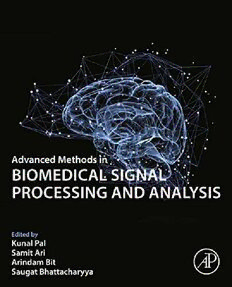
Advanced Methods in Biomedical Signal Processing and Analysis PDF
Preview Advanced Methods in Biomedical Signal Processing and Analysis
A D V A N C E D M E T H O D S I N B I O M E D I C A L S I G N A L P R O C E S S I N G A N D A N A L Y S I S A D V A N C E D M E T H O D S I N B I O M E D I C A L S I G N A L P R O C E S S I N G A N D A N A L Y S I S Edited by KUNAL PAL SAMIT ARI ARINDAM BIT SAUGAT BHATTACHARYYA AcademicPressisanimprintofElsevier 125LondonWall,LondonEC2Y5AS,UnitedKingdom 525BStreet,Suite1650,SanDiego,CA92101,UnitedStates 50HampshireStreet,5thFloor,Cambridge,MA02139,UnitedStates TheBoulevard,LangfordLane,Kidlington,OxfordOX51GB,UnitedKingdom Copyright©2023ElsevierInc.Allrightsreserved. Nopartofthispublicationmaybereproducedortransmittedinanyformorbyanymeans,electronicormechanical,including photocopying,recording,oranyinformationstorageandretrievalsystem,withoutpermissioninwritingfromthepublisher. Detailsonhowtoseekpermission,furtherinformationaboutthePublisher’spermissionspoliciesandourarrangementswith organizationssuchastheCopyrightClearanceCenterandtheCopyrightLicensingAgency,canbefoundatourwebsite:www.elsevier. com/permissions. ThisbookandtheindividualcontributionscontainedinitareprotectedundercopyrightbythePublisher(otherthanasmaybenoted herein). Notices Knowledgeandbestpracticeinthisfieldareconstantlychanging.Asnewresearchandexperiencebroadenourunderstanding, changesinresearchmethods,professionalpractices,ormedicaltreatmentmaybecomenecessary. Practitionersandresearchersmustalwaysrelyontheirownexperienceandknowledgeinevaluatingandusinganyinformation, methods,compounds,orexperimentsdescribedherein.Inusingsuchinformationormethodstheyshouldbemindfuloftheirown safetyandthesafetyofothers,includingpartiesforwhomtheyhaveaprofessionalresponsibility. Tothefullestextentofthelaw,neitherthePublishernortheauthors,contributors,oreditors,assumeanyliabilityforanyinjuryand/or damagetopersonsorpropertyasamatterofproductsliability,negligenceorotherwise,orfromanyuseoroperationofanymethods, products,instructions,orideascontainedinthematerialherein. ISBN978-0-323-85955-4 ForinformationonallAcademicPresspublications visitourwebsiteathttps://www.elsevier.com/books-and-journals Publisher:MaraConner AcquisitionsEditor:TimPitts EditorialProjectManager:FernandaA.Oliveira ProductionProjectManager:KameshRamajogi CoverDesigner:MilesHitchen TypesetbySTRAIVE,India Contributors JayaPrakashAllam DepartmentofElectronicsandCommunication Engineering,NationalInstituteofTechnologyRourkela,Rourkela, Odisha,India ArfatAnis DepartmentofChemicalEngineering,KingSaudUniversity, Riyadh,SaudiArabia SamitAri DepartmentofElectronicsandCommunicationEngineering, NationalInstituteofTechnologyRourkela,Rourkela,Odisha,India B.Arya Bio-signalsandMedicalInstrumentationLaboratory, DepartmentofBiotechnologyandMedicalEngineering,National InstituteofTechnologyRourkela,Odisha,India IndranilBanerjee DepartmentofBioscienceandBioengineering,Indian InstituteofTechnology,Jodhpur,India AnanyaBarui CenterofHealthcareScienceandTechnology,Indian InstituteofEngineeringScienceandTechnology,Shibpur,India DeeptiBharti DepartmentofBiotechnologyandMedicalEngineering, NationalInstituteofTechnology,Rourkela,India SaugatBhattacharyya UlsterUniversity,Londonderry,UnitedKingdom M.Boreyko GlushkovInstituteforCyberneticsofNationalAcademyof ScienceofUkraine,Kyiv,Ukraine PranjaliBorkar MolecularMedicineLaboratory,Departmentof Microbiology,AIIMS,Bhopal,India I.Chaikovsky GlushkovInstituteforCyberneticsofNationalAcademyof ScienceofUkraine,Kyiv,Ukraine SumitChakravarty DepartmentofElectricalEngineering,Kennesaw StateUniversity,Marietta,GA,UnitedStates RashmiChowdhary DepartmentofBiochemistry,AIIMS,Bhopal,India B.Dhananjay Bio-signalsandMedicalInstrumentationLaboratory, DepartmentofBiotechnologyandMedicalEngineering,National InstituteofTechnologyRourkela,Odisha,India ZahraEmrani MedicalImageandSignalProcessingResearchCenter, IsfahanUniversityofMedicalSciences,Isfahan,Iran xi xii Contributors MahnazEtehadtavakol DepartmentofMedicalPhysics,Schoolof Medicine;PoursinaHakimDigestiveDiseasesResearchCenter, IsfahanUniversityofMedicalSciences,Isfahan,Iran Yu.Frolov GlushkovInstituteforCyberneticsofNationalAcademyof ScienceofUkraine,Kyiv,Ukraine A.Kazmirchuk NationalMilitaryMedicalClinicalCenter“GVKG”,Kyiv, Ukraine ChenLiu SunYat-SenUniversity,Guangzhou,China ManojaK.Majhi DepartmentofBiotechnologyandMedical Engineering,NationalInstituteofTechnology,Rourkela,India AnvitaGuptaMalhotra MolecularMedicineLaboratory,Departmentof Microbiology,AIIMS,Bhopal,India SatyapriyaMohanty DepartmentofCardiothoracicandVascular Surgery,AllIndiaInstituteofMedicalSciences(AIIMS),Bhubaneswar, India SurajK.Nayak DepartmentofBiotechnologyandMedicalEngineering, NationalInstituteofTechnology,Rourkela,India I.Nedayvoda GlushkovInstituteforCyberneticsofNationalAcademyof ScienceofUkraine,Kyiv,Ukraine E.Y.K.Ng SchoolofMechanicalandAerospaceEngineering,Collegeof Engineering,NanyangTechnologicalUniversity,Singapore,Singapore KunalPal DepartmentofBiotechnologyandMedicalEngineering, NationalInstituteofTechnology,Rourkela,India AntonPopov ElectronicEngineeringDepartment,IgorSikorskyKyiv PolytechnicInstitute,Kyiv,Ukraine BikashK.Pradhan DepartmentofBiotechnologyandMedical Engineering,NationalInstituteofTechnology,Rourkela,India M.Primin GlushkovInstituteforCyberneticsofNationalAcademyof ScienceofUkraine,Kyiv,Ukraine SaeedMianQaisar ElectricalandComputerEngineeringDepartment; CommunicationandSignalProcessingLab,EnergyandTechnology ResearchCenter,EffatUniversity,Jeddah,SaudiArabia ChavaliRavikanth DepartmentofBiotechnologyandMedical Engineering,NationalInstituteofTechnology,Rourkela,India HaiderRaza UniversityofEssex,Colchester,UnitedKingdom DeepakK.Sahu DepartmentofBiotechnologyandMedicalEngineering, NationalInstituteofTechnology,Rourkela,India Contributors xiii SaunakSamantray DepartmentofETC,IIITBhubaneswar,Odisha, India AnganaSarkar DepartmentofBiotechnologyandMedicalEngineering, NationalInstituteofTechnology,Rourkela,India PreetamSarkar DepartmentofBiotechnologyandMedicalEngineering, NationalInstituteofTechnology,Rourkela,India SarmanSingh MolecularMedicineLaboratory,Departmentof Microbiology,AIIMS,Bhopal,India J.Sivaraman Bio-signalsandMedicalInstrumentationLaboratory, DepartmentofBiotechnologyandMedicalEngineering,National InstituteofTechnologyRourkela,Odisha,India N.PrasannaVenkatesh Bio-signalsandMedicalInstrumentation Laboratory,DepartmentofBiotechnologyandMedicalEngineering, NationalInstituteofTechnologyRourkela,Odisha,India SlawomirWilczynski DepartmentofBasicBiomedicalSciences, MedicalUniversityofSilesia,Katowice,Poland 1 Feature engineering methods Anton Popov ElectronicEngineeringDepartment,IgorSikorskyKyivPolytechnicInstitute, Kyiv,Ukraine 1. Machine learning projects development standards and feature engineering FeatureEngineeringisasetofactionsdevotedtopreparation ofthe rawdata collected from the objects under investigationto theusebyalgorithmsofautomatedanalysis.Thestepsinfeature engineering arethe following: 1. Exploratory data analysis and data preprocessing— understanding the quality and quantity of the input data and preparing it for further use. 2. Featureextraction—convertingtheavailabledataintodescrip- tive features. 3. Feature reduction by either selection of useful features or reducingthedimensionalityofthefeaturevectortokeeponly the valuable featuresfor furtheruse. Projects related to machine learning are being developed according to common practices which are formalized in a form of standards and frameworks. One of the most popular one is called CRISP-DM [1]: cross-industry standard process in data mining. It was developed in 1997, and since then it has a wide application in many domains where machine learning is used in data analysis for real applications. The CRISP-DM workflow is presented in Fig. 1. The process of machine learning model development starts with understanding the business domain and formulating the problemwhichshouldbesolved.Thisproblemisassociatedwith dataandultimatelyshouldbesolvedusingthedataavailable.Then starts the first stage of the Feature Engineering process: Data Understanding and exploration. After the characteristics of data areavailableanditisclearwhatitispossibletodowiththem,engi- neersstartpreparingthedatafortrainingthemodels.Intermsof AdvancedMethodsinBiomedicalSignalProcessingandAnalysis.https://doi.org/10.1016/B978-0-323-85955-4.00004-1 1 Copyright#2023ElsevierInc.Allrightsreserved. 2 Chapter1 Featureengineeringmethods Fig.1 CRISP-DMprocess diagram.Stagesoffeature engineeringhighlightedin green(grayintheprintversion). (Forinterpretationofthe referencestocolorinthisfigure legend,thereaderisreferredto thewebversionofthisarticle.) FeatureEngineering,thestagesofdataprocessing,featureextrac- tion and feature reduction are implemented and they constitute theDataPreparationstage.Thenthefeaturesarereadyformodel training and evaluation of their performance. This CRISP-DM stage either finishes the process, if business goals are achieved, oritrequiresanotheriterationofrequirementsclarificationfrom thebusinessperspective,andthenwalkingthroughthedataprep- aration,featureextractionandreduction,modeltrainingandeval- uation. So, feature engineering is embedded in the standard processofmachinelearningmodelsdevelopment,anddistributed acrossitstwostages:DataUnderstandingandDataPreparation. Same is valid for other existing data science project develop- ment frameworks, such as KDD and SEMMA [2]—every project hasthestagesrelatedtodataexploration,extractionandprepara- tion of features. 2. Exploratory data analysis Everyinvestigationofeitherasinglepatientvisitingthedoctor, or a large cohort of multicentral clinical studies starts from col- lecting a lot of raw data from participating subjects. This data is
